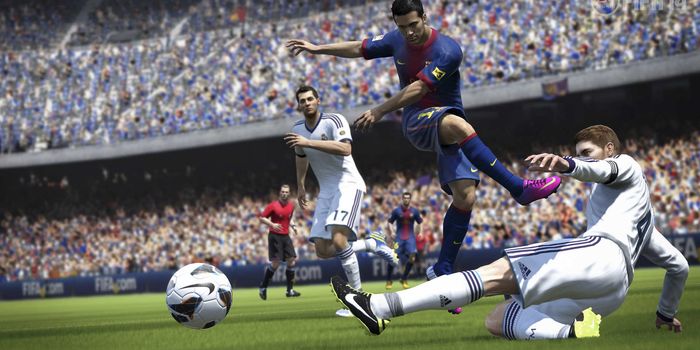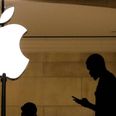With a new console and a hugely impressive new title, the next generation FIFA is like playing a different game
The transition between current generation consoles and the next generation, due out next month, is one that JOE has been fairly uneasy about. With a lot of work down the line from the producers to make games step up to the mark of the technology that’s now at their disposal.
As with the last transition, we though we’d see a lot of the same games on both consoles, with very little to choose between them, and given the fact that one of the most impressive games that we may well have ever seen, GTA V, has been released on the current gen consoles, we thought there might not be a whole lot to shout about when we played the new Xbox One. In terms of graphics, an improvement was expected of course, but there was a whole lot more to come from the next generation FIFA.
In short, it feels like this was the game that the team wanted to make, and the version that the current gen consoles got was the pared down version. The new consoles allow producers to make new physics, new animations and overall make the game flow that much better. For the first time in a long time there were very few frustrations with the passing, the shooting or refereeing, and we really enjoyed playing FIFA again.
We sat down to chat with the producer, Nick Channon, who ran us through the changes, what the main differences were, and the challenge of making a new game every year for a passionate fan base.
JOE: What are the main differences we’ll see between this gen and next generation?
Nick Channon: Unlike other console transitions, most of the game modes will transfer over like Ultimate Team, Career Mode and so on. On top of that, we’ve done some really deep innovation in terms of gameplay, which is driven by the new EA Sports Ignite engine. This engine is for all the sports games that EA makes going forwards, and we’re really excited about it. With the power of the new console, we’re able to do a lot more with the physics, so for example when a player slides in they can now brace for impact and ride the challenge, and they don’t necessarily fall over.
There’s also a huge difference in how players interact with one another, where players can now use their body to shield the ball, get a better position. Overall, there are simply hundreds of new animations for everything from passing to first touch to shooting. This makes the game fell much more fluid and connected.
JOE: Living Worlds is a feature that we saw pushed heavily on next-gen consoles, how does that work?
NC: This is something that is a huge part of the next title and we’re really excited about it. The game is now much closer to a real match day experience. We have 3D crowds for the first time now, so you can see home fans celebrating wildly when a goal is scored and that doesn’t happen in the away section, it makes the game feel much more like a real match, with different fans reacting differently. These things just weren’t possible before.
JOE: From a developer’s point of view, you’ve got more power on the new consoles, but does that make for more expectations?
NC: Whenever you move to a new console it’s a huge challenge, but moving from one console to another is one of the coolest things you can do when making games. Now, we can do a whole lot more than we could before, we have the 3D crowds, we have a lot more on the physical animations, and the game feels much more alive than before.
JOE: Next gen solves the problems of memory and graphics, but it doesn’t solve the prob of making a gripping game. How does that work when it comes to FIFA, where you have to make a new version of essentially the same game every year?
NC: It’s not easy, but we have a hugely talented team. We’re fortunate that we love this sport, we get new inspiration every single week from watching football, so for us we use that to make the best game that we can. We want to make sure we maintain the quality that we’ve built up over these last few years.
JOE: Is there more that you can do with Artificial Intelligence this year on the new consoles? Will that allow for differing referee’s decisions, maybe even the addition of referee error?
NC: We wouldn’t do that with FIFA, it’s something we simply wouldn’t choose to do across our titles. For us, it’s a case of evaluating what areas we want to innovate in and what the machine can do. For this year we looked at physics and motion, which is where we felt we could get the most out of it.
JOE: How do players feel about their ratings in real life, and how much of a challenge was it getting the list of legends together for Ultimate Team on Xbox? Were there fisticuffs over whose favourite player made the cut?
NC: I wouldn’t say there were fisticuffs! We got 42 legends in on the Xbox collaboration, and we really couldn’t be much happier with the players we were able to get. It’s a great mix of recently retired players, players that are from many years ago and a great mix of positions. We think that fans are really going to enjoy being able to play with these legends.
In terms of ratings we have a huge team that works on that in particular, and they have contacts in all the regions where we support the leagues. It’s a huge undertaking by a team that have been doing it for quite a while, and they’re very good at what they do. We also have the matchplay feature which allows us to update ratings and form on a regular basis depending on how each player is getting on, which is a real help on that front. That said, we’ve never had Ronaldo or Messi on the phone complaining anyway!
JOE: Recently, the players of Leyton Orient had to have FIFA 14 taken off their team bus because it was becoming too much of a distraction. Do you guys take that as a compliment?
NC: Ultimately it’s great to hear that there are people playing your game, and we take feedback from our community really seriously. When it’s professional football players doing that, it’s an extra bit of a compliment too, it means we’ve done something right!
After chatting to Nick, we were allowed to get our hands on the game for a few hours, and overall, this is a much bigger leap than we originally thought it was going to be. We noticed that there were huge differences from set pieces, where now more than two players could jump up for a ball, passing animations were a lovely small touch that made the game flow much better, and there was a huge difference in tackling.

It seemed that players were better able to respond to what we wanted them to do, and rather than throwing in big heavy sliding tackles, they would commit to a challenge and get their body in the way, instead of risking the red card with a leg-breaking slide. Skills were much more responsive too, and the game now barely ever stops flowing. When a ball goes out, either a player runs to retrieve it or a ball boy throws another one on, and sometimes even both. This leads players to coming over and kicking the ball off the pitch before starting up again. Essentially this means that you can’t switch off as the game can kick back in to gear at any stage.
What it all boils down to really is whether or not this game represents enough of a change and a step forward for us to part with our hard earned cash for a new console next month. Before we got a chance to go hands on we weren’t too sure, and though we’d seen plenty of hype, we thought we’d wait to see how the whole thing pans out. After playing, we’re fully convinced that it’s worth the cash and if we’re honest, we find it really difficult to go back to playing current gen FIFA, it really is a totally different game. We’ll see you in the queue on November 22nd.
LISTEN: You Must Be Jokin’ with Conor Sketches | Tiger Woods loves Ger Loughnane and cosplaying as Charles LeClerc


















































